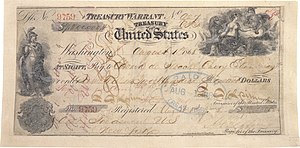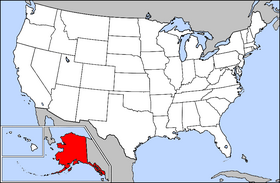Alaska Purchase

The Alaska Purchase, historically also referred to as Seward's Folly, was the purchase of Alaska by the United States from the Russian Empire in 1867. The purchase, done at the behest of United States Secretary of State William H. Seward, gained 586,412 square miles (1,518,800 km²) of new United States territory. Originally organized as the Department of Alaska, the area was successively the District of Alaska and the Alaska Territory before becoming the modern state of Alaska upon being admitted to the Union in 1959.
Background
Russia was in a difficult financial position and feared losing Russian Alaska without compensation in some future conflict, especially to the British, whom they had fought a decade earlier in the Crimean War. While Alaska attracted little interest at the time, the population of nearby British Columbia started to increase rapidly after hostilities ended. The Russians therefore started to believe that in any future conflict with Britain, their hard-to-defend region might become a prime target, and would easily be captured. Therefore Tsar Alexander II decided to sell the territory. Perhaps in hopes of starting a bidding war both the British and the Americans were approached, however the British expressed little interest in buying Alaska. The Russians then turned their attention to the United States and in 1859 offered to sell the territory to the United States, hoping that the United States would off-set the plans of Russia's greatest regional rival, Great Britain. However, no deal was brokered due to the secession of seven southern states and the eventual American Civil War.[1]
Following the Union victory in the American Civil War, the Tsar then instructed the Russian minister to the United States, Eduard de Stoeckl, to re-enter into negotiations with Seward in the beginning of March 1867. The negotiations concluded after an all-night session with the signing of the treaty at 4 o'clock in the morning of March 30, 1867[2] with the purchase price set at $7,200,000, about 1.9¢ per acre ($4.74/km2).[3] American public opinion was generally positive, but some newspapers editorialized against the purchase. Horace Greeley of the New York Tribune wrote:
Already, so it was said, we were burdened with territory we had no population to fill. The Indians within the present boundaries of the republic strained our power to govern aboriginal peoples. Could it be that we would now, with open eyes, seek to add to our difficulties by increasing the number of such peoples under our national care? The purchase price was small; the annual charges for administration, civil and military, would be yet greater, and continuing. The territory included in the proposed cession was not contiguous to the national domain. It lay away at an inconvenient and a dangerous distance. The treaty had been secretly prepared, and signed and foisted upon the country at one o'clock in the morning. It was a dark deed done in the night.... The New York World said that it was a "sucked orange." It contained nothing of value but furbearing animals, and these had been hunted until they were nearly extinct. Except for the Aleutian Islands and a narrow strip of land extending along the southern coast the country would be not worth taking as a gift.... Unless gold were found in the country much time would elapse before it would be blessed with Hoe printing presses, Methodist chapels and a metropolitan police. It was "a frozen wilderness.[4]
While criticized by some at the time the financial value of the Alaska purchase turned out to be many times greater than what the United States had paid for it. The land turned out to be resource rich (including oil) and also provided the United States a great advantage in the Cold War.
The viewpoint from Washington

The purchase was at the time derided as "Seward's folly," "Seward's icebox," and Andrew Johnson's "polar bear garden," because it was believed foolhardy to spend so much money on the remote region.[5]
Seward, the main force behind the treaty, had long favored expansion. U.S. Senator Charles Sumner of Massachusetts, the chairman of the Senate Committee on Foreign Relations, agreed that the nation's strategic interests favored the treaty. Russia had been a valuable ally of the Union position during the American Civil War, while Britain had been a nearly open enemy. It seemed wise to help Russia while discomfiting the British. Furthermore there was the matter of adjacent territories belonging to Britain (namely the Colony of British Columbia, which in 1871 became part of Canada). Were Alaska to be purchased, they would be nearly surrounded by the United States, they were asserted by the United States to be of little strategic value to Britain, and they might someday be purchased. The purchase, editorialized the New York Herald, was a "hint" from the Tsar to England and France that they had "no business on this continent." "It was in short a flank movement" upon Canada, said the influential New York Tribune. "Soon the world would see in the northwest "a hostile cockney with a watchful Yankee on each side of him," and John Bull would be led to understand that his only course was a sale of his interests there to Brother Jonathan."

On March 3 Sumner made a major speech advocating the treaty, and covering in depth the history, the climate, the natural configuration, the population, the resources—the forests, mines, furs, fisheries—of Alaska. A good scholar, he cited the testimony of geographers and navigators: Alexander von Humboldt, Joseph Billings, Yuri Lisiansky, Fyodor Petrovich Litke, Otto von Kotzebue, Portlock, James Cook, John Meares, Ferdinand von Wrangel. When he had finished, he observed that he had "done little more than hold the scales." If these had inclined on either side, he continued, it was "because reason or testimony on that side was the weightier." Soon, said Sumner, "A practical race of intrepid navigators will swarm the coast ready for any enterprise of business or patriotism. Commerce will find new arms; the country new defenders; the national flag new hands to bear it aloft." Bestow American republicanism upon the territory, he urged, "and you will bestow what is better than all you can receive, whether quintals of fish, sands of gold, choicest fur or most beautiful ivory." "Our city," exclaimed Sumner, "can be nothing less than the North American continent with the gates on all the surrounding seas." He argued the treaty was "a visible step" in this direction. By its terms we should "dismiss one more monarch from this continent." One by one they had retired—" first France; then Spain; then France again, and now Russia, all giving way to that absorbing unity which is declared in the national motto — E pluribus unum."[6]
Seward's Day, a holiday in honor of Seward, is celebrated in Alaska on the last Monday of March to mark the American purchase of Alaska. Seward's Day is also an alcohol-free day in many cities such as Ketchikan, one of the major cities of the Alaska Panhandle — though the one-day alcohol ban is not observed in all cities.
Ratification and enactment

The United States Senate ratified the treaty on April 9, 1867, by a vote of 37-2. However, the appropriation of money needed to purchase Alaska was delayed by more than a year due to opposition in the House of Representatives. The House finally approved the appropriation in July 1868, by a vote of 113-48.[7]
Sumner reported Russian estimates that Alaska contained about 2,500 Russians and those of mixed race, and 8,000 Indigenous people, in all about 10,000 people under the direct government of the Russian fur company, and possibly 50,000 Eskimos and Alaska Natives living outside its jurisdiction. The Russians were settled at 23 trading posts, placed conveniently on the islands and coasts. At smaller stations only four or five Russians were stationed to collect furs from the Indians for storage and shipment when the company's boats arrived to take it away. There were two larger towns. New Archangel, now named Sitka, had been established in 1804 to handle the valuable trade in the skins of the sea otter and in 1867 contained 116 small log cabins with 968 residents. St. Paul in the Pribilof Islands had 100 homes and 283 people and was the center of the fur seal industry.
An Aleut name, "Alaska," was chosen by the Americans. The transfer ceremony took place in Sitka on October 18, 1867. Russian and American soldiers paraded in front of the governor's house; the Russian flag was lowered and the American flag raised amid peals of artillery. Captain Alexis Pestchouroff said, "General Rousseau, by authority from His Majesty, the Emperor of Russia, I transfer to the United States the territory of Alaska." General Lovell Rousseau accepted the territory. A number of forts, blockhouses and timber buildings were made over to the Americans. The troops occupied the barracks; General Jefferson C. Davis established his residence in the governor's house, and most of the Russian citizens went home, leaving a few traders and priests who chose to remain.
Alaska Day celebrates the formal transfer of Alaska from Russia to the United States, which took place on October 18, 1867. October 18, 1867, was by the Gregorian calendar and a clock time 9:01:20 behind Greenwich, which came into effect the following day in Alaska to replace the Julian calendar and a clock time 14:58:40 ahead of Greenwich. For the Russians, the handover was on October 7, 1867.
Modern viewpoints in Russia
There are many myths on the sale of Alaska that exist in Russia. Many believe Alaska was sold by Catherine II, who was the Empress one-hundred years before the actual sale. Many believe that Alaska was not sold, but rented for 99 years, and supposedly Brezhnev refused to take it back. It is claimed the Russians did not receive money for the sold territory. There are also claims that the British barque Orkney, assigned to carry gold to St. Petersburg, was blown up by a terrorist and subsequently sank in the Baltic Sea.[8]
See also
Notes
- ^ *"Purchase of Alaska, 1867".
- ^ Seward, Frederick W., Seward at Washington as Senator and Secretary of State. Volume: 3, 1891, p. 348
- ^ A simple consumer price index calculation would put this at the equivalent of around one hundred million dollars in 2007; however, given the scale of the project, it would be more appropriate to consider the cost as a fraction of the national wealth, in which case it would be the equivalent of around eleven billion dollars today. Considered as a fraction of government expenditure, it would be even larger; the federal government in 1867 had a far smaller budget as a proportion of GDP than it does today, and so the Alaska Purchase represented a more significant investment to the government than the figure of eleven billion dollars would suggest. For calculations, see "Six Ways to Compute the Relative Value of a U.S. Dollar Amount", Samuel Williamson, 2008.
- ^ Oberholtzer, Ellis Paxson. A History of the United States since the Civil War. Volume: 1. 1917. p. 123
- ^ Have you been to the "polar bear garden"? The loc.gov Wise Guide
- ^ Oberholtzer, Ellis Paxson. A History of the United States since the Civil War. Volume: 1. 1917. p. 544-5
- ^ "Treaty with Russia for the Purchase of Alaska: Primary Documents of American History (Virtual Programs & Services, Library of Congress)". Loc.gov. Retrieved 2008-09-15.
- ^ Who had sold Alaska and how (in Russian)
References
- Jensen, Ronald (1975). The Alaska Purchase and Russian-American Relations.
- Oberholtzer, Ellis (1917). A History of the United States since the Civil War. Vol. vol 1.
{{cite book}}:|volume=has extra text (help) - Alaska. Speech of William H. Seward at Sitka, August 12, 1869 (1869; Digitized page images & text), primary source.



